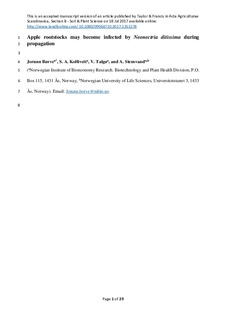| dc.contributor.author | Børve, Jorunn | |
| dc.contributor.author | Kolltveit, Svein André | |
| dc.contributor.author | Talgø, Venche | |
| dc.contributor.author | Stensvand, Arne | |
| dc.date.accessioned | 2018-08-22T13:06:22Z | |
| dc.date.available | 2018-08-22T13:06:22Z | |
| dc.date.created | 2018-01-04T14:01:28Z | |
| dc.date.issued | 2018-07-18 | |
| dc.identifier.citation | Acta Agriculturae Scandinavica - Section B. 2018, 68 (1), 16-25. | nb_NO |
| dc.identifier.issn | 0906-4710 | |
| dc.identifier.uri | http://hdl.handle.net/11250/2558898 | |
| dc.description.abstract | Introduction and purpose: The ability of apple rootstocks to become infected by Neonectria ditissima, the cause of European canker, was studied over two years. Materials and methods: Rootstocks B9 and M9 with a size suitable for grafting (6-10 mm stem diameter, termed rootstocks), and smaller sized rootstocks (<5 mm stem diameter, termed transplants) of B9, M9, M26, MM106 and Antonovka were inoculated with N. ditissima at different times, either with contaminated map pins or with spore suspensions. In addition, the rootstocks were either defeathered (side shoots removed), topped (top shoot headed) or both, to create wounds that would normally occur during propagation, while wounds on transplants were made by removing leaves. Results and discussion: One month after inoculation, slightly sunken canker lesions had developed around the inoculation points of the map pins or wounds. No lesions developed on the non-inoculated controls. Map pin inoculation resulted in 30% to 89% infection and spore suspension sprayed on wounds from 5% to 45% infection. When the cankered areas were split open, brown lesions with necrotic tissue due to infection by N. ditissima appeared. The transplants of M9, M26 and MM106 inoculated with contaminated map pins in 2014 developed necrosis on 40% to 67% of the plants, but there were no differences in the incidence or severity among the different types. On the transplants of B9, Antonovka and M9 inoculated in 2015, there was more necrosis on B9 (42%) than on Antonovka (11%) and more sporulating lesions on B9 (29%) than on M9 (9%) or on Antonovka (4%). Conclusion: It can be concluded that rootstocks used for apple trees may become infected by N. ditissima, and wounds should thus be protected during propagation. | nb_NO |
| dc.language.iso | eng | nb_NO |
| dc.publisher | Taylor & Francis Group | nb_NO |
| dc.subject | European canker | nb_NO |
| dc.subject | inoculation experiments | nb_NO |
| dc.subject | Malus × domestica | nb_NO |
| dc.subject | Nectria galligena | nb_NO |
| dc.subject | susceptibility | nb_NO |
| dc.title | Apple rootstocks may become infected by Neonectria ditissima during propagation | nb_NO |
| dc.type | Journal article | nb_NO |
| dc.type | Peer reviewed | nb_NO |
| dc.description.version | acceptedVersion | nb_NO |
| dc.rights.holder | © 2017 Informa UK Limited, trading as Taylor & Francis Group | nb_NO |
| dc.subject.nsi | VDP::Landbruks- og Fiskerifag: 900::Landbruksfag: 910::Planteforedling, hagebruk, plantevern, plantepatologi: 911 | nb_NO |
| dc.source.pagenumber | 16-25 | nb_NO |
| dc.source.volume | 68 | nb_NO |
| dc.source.journal | Acta Agriculturae Scandinavica - Section B | nb_NO |
| dc.source.issue | 1 | nb_NO |
| dc.identifier.doi | 10.1080/09064710.2017.1351578 | |
| dc.identifier.cristin | 1535940 | |
| dc.relation.project | Norges forskningsråd: 269209 | nb_NO |
| cristin.ispublished | true | |
| cristin.fulltext | postprint | |
| cristin.qualitycode | 1 | |
